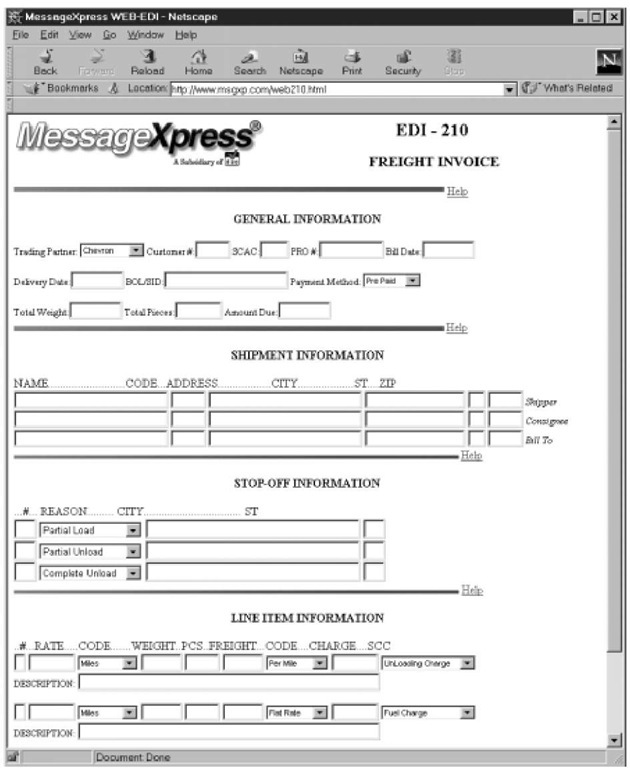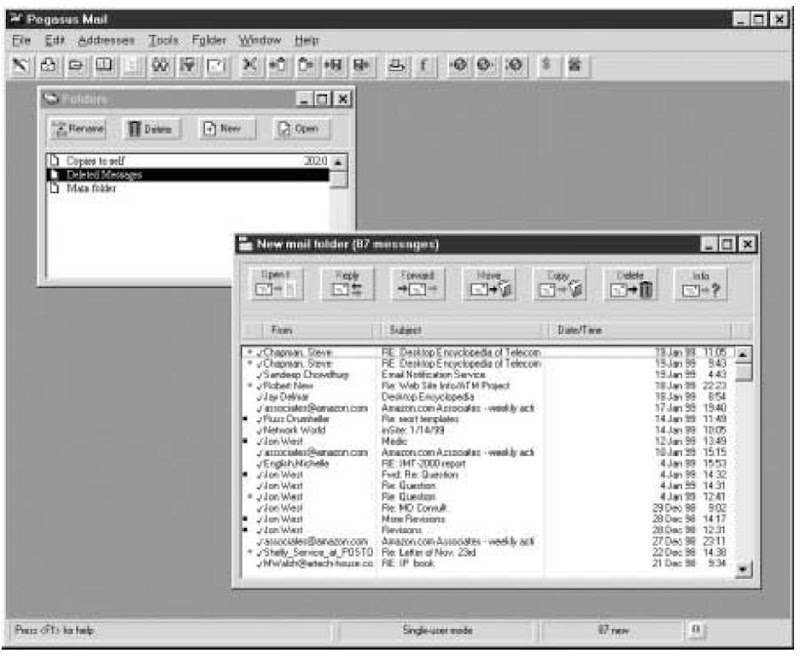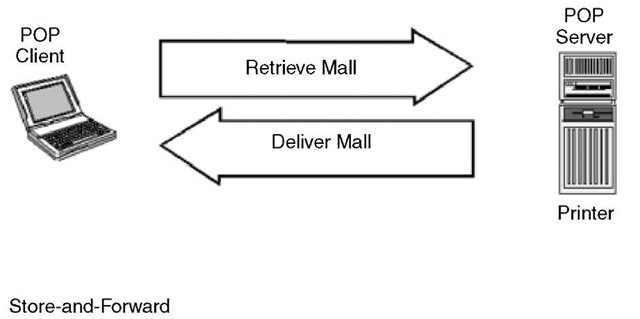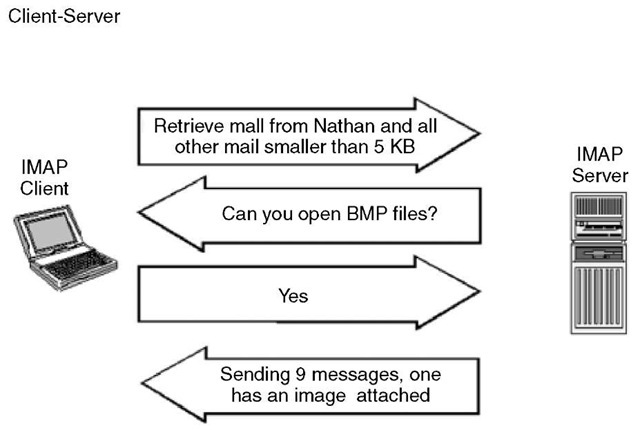Electronic mail (e-mail) is a method for transmitting and receiving text, data, and images over a network. The advantages of e-mail include fast delivery and cost savings compared to regular postal mail, overnight carrier services, and traditional facsimile (fax).
Several kinds of e-mail systems are in use today. There are the internal client/server e-mail systems used by large corporations, which operate over local area networks (LANs). There are also mainframe- and minicomputer-based e-mail systems in the corporate environment, but these have largely given way to client/server e-mail systems with the transition to LANs. Online services and Internet service providers offer e-mail accounts as part of the subscription price for bulletin board and/or Web access. Many e-mail programs can be downloaded from the Internet as shareware (Figure 37). Public e-mail services are also offered by telephone companies and longdistance carriers, as well as wireless data service providers.
Figure 36
A MessageXpress Web Basic EDI form for a freight invoice.
Electronic mail enhances business transactions by replacing paper forms and manual delivery systems with faster, more reliable computer communications. With information stored in digital form—and conveyed electronically between computers and other communications devices such as personal digital assistants (PDAs), pagers, and wireless phones— messages can be easily edited and integrated into other applications. Just as important, e-mail can be accessed virtually anywhere, anytime. In addition to various wireless services that make this possible, mobile professionals can access and manage their e-mail through the Internet.
Figure 37
A popular full-featured shareware e-mail program is Pegasus Mail, written by David Harris.
Electronic mail is also the key enabler of e-commerce on the Internet. A user might select items from an online catalog, for example, and then enter delivery and credit-card information into a form, which is e-mailed to the company’s Web server for processing. Various e-commerce protocols make online purchasing secure and reliable.
Features
There are numerous e-mail products to choose from, and they are available from dozens of vendors. The most sophisticated products have reached the point where they now offer a fairly standard set of features, including:
AUTOFORWARDING Automatically redirects mail to another account. This is especially useful when recipients are away on vacation and someone else must handle their job responsibilities. Recipients can also receive a copy even if the e-mail is autoforwarded to someone else.
AUTOMATED RESPONSES Lets recipients automate replies to messages, either selectively or globally. For every incoming message, recipients can have a reply sent indicating that they are on vacation and will not be checking email, for example. Alternatively, recipients can choose to receive only high-priority messages or messages from specific e-mail addresses.
CLICKABLE E-MAIL ADDRESSES Automatically opens a message compose window when users click on an e-mail address appearing in the body of the message.
CLICKABLE URLS Automatically opens a Web browser and goes to the selected URL (Uniform Resource Locator) appearing in the body of the message.
COLOR-CODED MESSAGE LABELING Lets users apply different colors to messages listed in the inbox. Some products allow parts of a message—body text, URL or e-mail address, and reply text—to be color-coded as well.
COMPRESSION After messages are deleted from the various file folders, the e-mail program performs compression to reclaim disk space.
CONTEXT-SENSITIVE ONLINE HELP Lets users click on items in the user interface to read brief explanations of what functions they perform.
DEFAULT ROUTING Lets users specify the default address for recipients in the address book who have multiple e-mail addresses.
DISTRIBUTION LISTS Lets users create a list of addresses for mass mailings. This list has its own name and, when entered in the To: field, the message and attachment are sent to all addresses on the list without displaying the e-mail address of every person.
DRAFT Incomplete messages can be saved in a file folder, allowing users to continue working on them at a later time.
E-MAIL ALERTS The e-mail program can be configured so, when it is running in the background, an audio tone or visual alert signals users when new mail arrives.
EXCEPTIONS Allows users to exempt specified addresses from a mailing list, without having to create a new list.
EXPANDED TEXT Allows users to store abbreviations for commonly used text strings in a message, which can be expanded at any time with a single keystroke.
FILTERS Allows incoming messages to be identified by a variety of criteria so the appropriate action can be taken on them automatically. For example, nuisance messages from a specific e-mail address can be deleted automatically from the inbox. Filters can check for key words in the subject line, allowing certain messages to be saved automatically in a specific file folder or the e-mail address automatically added to a distribution list.
INCREMENTAL MAILINGS Allows users to break up very large lists to expedite mass mailings.
LIST SUPPRESSION In distribution lists, instead of having the e-mail address of every recipient listed, users can suppress them by substituting a list name.
MAILBOX MANAGEMENT Allows users to create any number of file folders to arrange incoming messages by such criteria as date, time, author, and subject.
MAPI SUPPORT A MAPI (Mail Applications Programming Interface) utility built into the e-mail program allows users to send files directly from MAPI-compliant applications, including word processors and spreadsheets, as e-mail attachments.
MULTIPLE ACCOUNTS MANAGEMENT Allows users to manage multiple e-mail accounts and switch between them via hot keys or the point-and-click method.
NESTED MAILING LISTS Allows users to embed other mailing lists (child lists) within another mailing list (parent list).
NICKNAMES Also called aliases, allows users to map the real names of individuals to their e-mail address.
POLL TIME Allows users to determine how frequently the e-mail program scans the server for new mail while the program is open and connected to the service provider.
REMINDER Also called a tickler, allows users to send messages to themselves with a specified delivery date to remind them of important occasions, deadlines, or events.
REMOVE EXPIRED MESSAGES Automatically removes messages from the server if the message is a specified number of days old and has already been read.
SCHEDULED DELIVERY Allows users to compose messages offline, save them in an outbox, and send them all at once automatically on a designated date or time.
SIGNATURE Allows users to create a standard signature or “sign-off” that is automatically placed at the end of every outgoing message. Multiple signatures can be created and used as appropriate for personal or business mail.
SPELL CHECKER Checks the spelling of text in e-mail messages before they are sent.
STYLIZED TEXT CAPABILITIES Lets users format messages using various fonts, colors, and sizes.
UNIX-TO-UNIX ENCODE/DECODE Some e-mail products include the capability to automatically UU encode/decode files without resorting to external utilities.
VOICE RECORDING Allows users to record an audio message and send it as an e-mail attachment.
Protocols
In the Internet environment, the two key e-mail protocols are the Post Office Protocol, version 3 (POP3) and the Simple Mail Transfer Protocol (SMTP). Although these are the most prevalent protocols for retrieving and sending e-mail, respectively, newer protocols overcome the limitations of POP3 and SMTP. The Internet Message Access Protocol, version 4 (IMAP4) will eventually take the place of POP3, while the Extended Simple Mail Transfer Protocol (ESMTP) will eventually take the place of SMTP.
POP3 POP3 is an Internet standard that defines a mechanism for accessing a mailbox located on a remote host machine (i.e., a server). This protocol is necessary because a user’s computer, particularly a mobile computer, will not usually be online all the time and consequently will not always be available to receive mail directly from the Internet. A larger machine, such as a UNIX server, will typically be online all the time and so is better suited to receiving e-mail on behalf of its clients. When a client establishes a connection to the server, POP3 retrieves the new mail.
SMTP Whereas POP3 is used for retrieving new mail from a UNIX server, SMTP sends mail to the server and moves it among other servers on the Internet. SMTP plays two roles, sender and receiver. The sender acts as a client and establishes a TCP connection with a receiver, which acts as a server. During an SMTP session, the sender and receiver exchange a sequence of commands and responses. The receiver announces its host name and then the sender announces its host name, followed by the message originator and message recipient(s). The mail data is then transmitted until a line containing carriage-return and line-feed characters is reached, which indicates that the message is complete. SMTP adds the time the message is sent and keeps track of all the hosts that relayed the message, as well as the time that each received the message.
IMAP4 POP3 works best when only one computer is used for e-mail, since it was designed to support offline message access, wherein messages are downloaded and then deleted from the mail server. POP3 does not work well for mobile professionals who typically use a notebook or palmtop computer on the road and desktop computers at the office and home. This mode of access is not compatible with access from multiple computers since it tends to sprinkle messages across all the computers used for email access, making management difficult. Unless all the computers share a common file system, the offline mode of access that POP3 was designed to support effectively ties the user to one computer for message storage and manipulation—which, for many mobile professionals, is impractical.
With IMAP4, users can request messages (both new and saved) that meet specific criteria, and manage them from more than one computer (Figure 38). Although IMAP was originally developed in 1986 at Stanford University, it has only recently become appreciated by mainstream e-mail vendors. The reason is that the problems of POP3 did not become apparent until fairly recently, with the dramatic increase in the number of mobile professionals, field personnel, telecommuters, and staff at small branch offices. Since these people typically use multiple computers, IMAP was rediscovered to address the problem of e-mail retrieval and management by a highly distributed workforce.
IMAP gives users more choices about what categories of messages to fetch from the server, where to store them, and what the server should do with specific categories of read messages. Among the key functions supported by IMAP4 that are not provided by POP3 are:
ACCESS AND MANAGEMENT OF MULTIPLE MAILBOXES This includes the ability to name and access different incoming and archive message folders, and the ability to list, create, delete, and rename them. These mailboxes can be on the same server or on different servers. An IMAP client may allow users to see the mailboxes at the same time, and move messages from one to the other.
Figure 38
A comparison of POP versus IMAP POP is a simple store-and-forward delivery mechanism (top), whereas IMAP establishes a client/server relationship that allows the server to be used to filter and store mail (bottom).
SUPPORT FOR CONCURRENT ACCESS TO SHARED MAILBOXES This capability is useful when multiple individuals are processing messages coming into a common inbox. Changes in mailbox state can be presented to all concurrently active clients.
MANIPULATION OF PERSISTENT MESSAGE STATUS FLAGS Messages in the mail repository can be marked with various status flags (eg., “deleted” and “answered”) and stay in the repository until explicitly removed by the user.
STORAGE FLEXIBILITY Users can save messages directly on either the client or server machine, or be given the choice of doing both as circumstances dictate.
ONLINE PERFORMANCE OPTIMIZATION This capability is especially useful over low-speed links and entails fetching the structure of a message without actually downloading it, selectively fetching individual message parts and using the server to search in order to minimize data transfer between client and server. With multimedia or multipart MIME (Multipurpose Internet Mail Extension) messages, for example, transferring selected parts of a message can be a huge advantage, for example when a user is in a hotel room and receives a short text message with a 5MB video clip attached.
DISCONNECT MODE In addition to allowing users to work in online and offline modes, IMAP supports a disconnect mode. Using this mode, the mail client can disconnect from the network and then synchronize with the mail server when the connection is reestablished.
ACCESS TO DATA OTHER THAN E-MAIL In addition to e-mail, users can uniformly access other classes of data, including documents in their native format.
ESMTP ESMTP is a collection of enhancements to SMTP, including those that improve its reliability and performance. For example, a feature called checkpointing reconstructs interrupted message transmissions when the connection is reestablished. Pipelining lets multiple message commands be sent at once. ESMTP also supports authentication, answering corporate concerns about the security of SMTP. These and other enhancements make SMTP more competitive with X.400 for linking business client/server e-mail systems on the LAN with those of public carriers, commercial online services and Internet service providers.
Last Word
While various proprietary electronic mail systems have been used for some time for internal communication within many organizations, Internet e-mail offers open communication on a truly global scale. Many businesses that have experienced the convenience and effectiveness of internal e-mail are now looking to the Internet as a way of extending its reach to local, national, and international locations. The X.400 gateway protocol solves many of the problems of linking and integrating dissimilar, geographically distributed messaging systems in support of e-mail and message-enabled applications.




